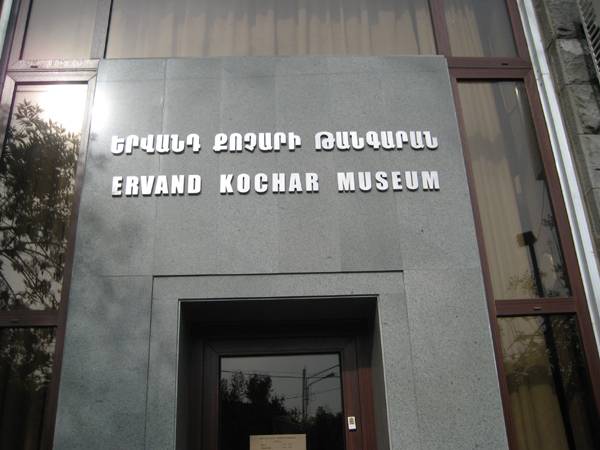
Armenian News Network / Groong
February 15, 2007
Travel Wire
By Ruth Bedevian
YEREVAN, ARMENIA

|
| Yervand Kochar Museum Entrance |
Another outstanding sculpture by Kochar that adorns this capital city of Yerevan is Vartan Mamigonian (1975). Located on Khanjian Street not far from where today's tourists frequent the Vernisage, it is a piece that the artist deeply desired to create and it took him several years from inception to completion. According to eminent art critic Henrik Igityan, `The sculpture has the distinction of having only one support in the middle - a stylized cloud of dust. All the four hoofs of the horse are off the ground and this intensifies the effect of an impetuous gallop.'
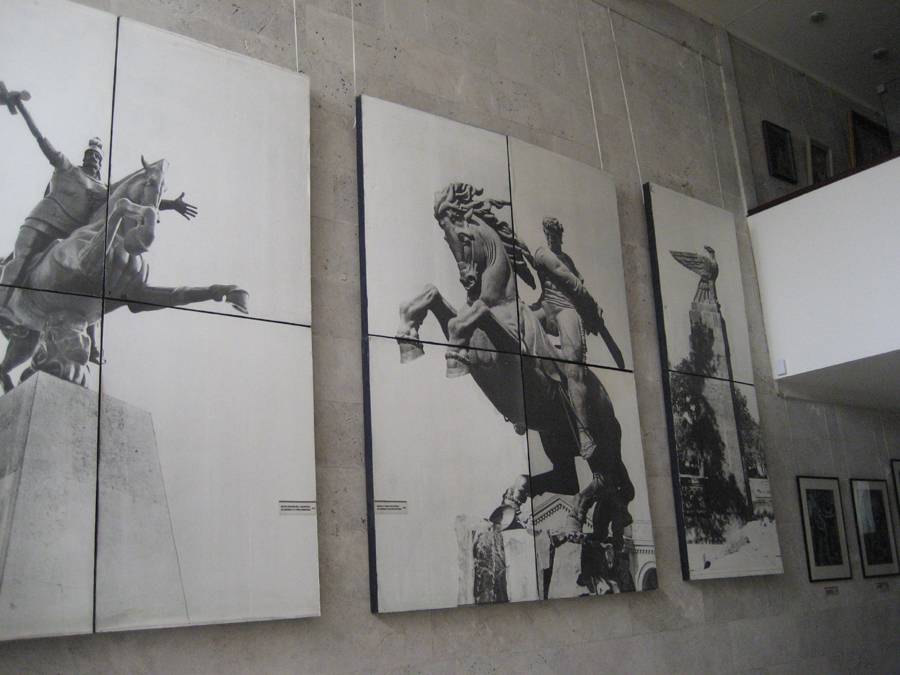
|
| Yervand Kochar Museum Lobby |
Constructed on the site of the artist's studio not far from where Mashtots Street crosses with Mascovyan Street and with a view of the Opera House across the circular intersection, the museum was opened in 1984. The artist's third wife, Manik Megerdicyan [1] and his two sons, Ruben and Haigov, with the help of government monies as well, established this most up-to-date building replete with climate control, travertine walls, marble floors, light-filled interior space and rules that prohibit snapping photos (except in the lobby entrance).
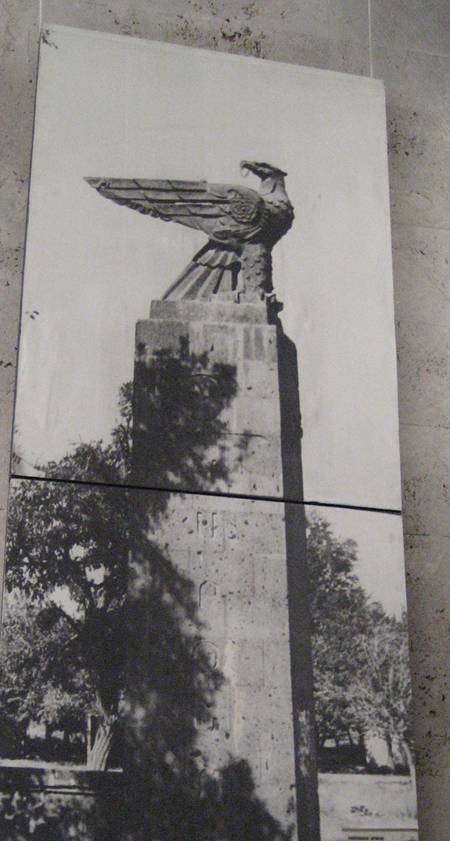
|
| The Eagle of Zvartnots |
Kochar revolutionized traditional painting when he introduced the concept of time and space into the visual arts. Known as `Painting in Space,' there are four pieces on exhibit in the museum. Only one other museum in the world exhibits works of Kochar's `Painting in Space' - the Pompidou Center in Paris.[2] All others are in private collections. Spanish Prisoners (1968); Images - Biblical Themes (1974-75); Yerevan-Erepooni (1968 -in celebration of the 2750th anniversary of Yerevan) and Morning (1962) are a series of images that merge into each other as they rotate on a pedestal which is generated by electricity. Kochar enables the spectator to view the painting in relationship to time and movement. Viewing these four pieces is a phenomenal experience! Kochar first crafted such art in a combination of wood and metal and later on he worked exclusively in metal. He became one of twenty visionary artists who signed the Dimensionist Manifesto authored by a Hungarian poet Karoly (Charles) Sirato in 1936 (an artistic trend that called for abandoning traditional approaches in favor of a fourth dimension in painting, sculpture, also literature). Such a theory opened vistas for experimentation to create multimedia art, cosmic art, art which merged time and space. Other famous names among the signers included Wassilly Kandinsky, Marcel Duchamp, Joan Miro, Francis Picabia.
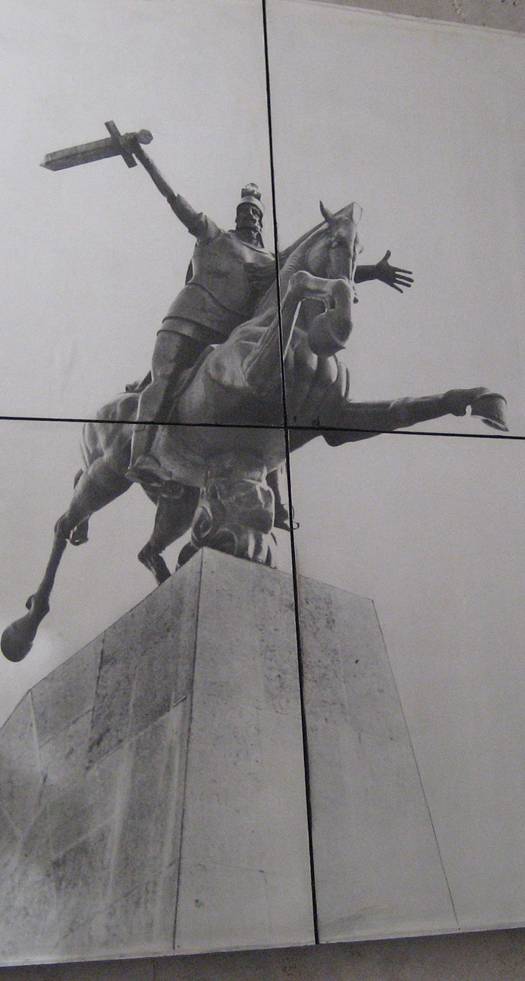
|
| Vartan Mamigonian |
Anna summarized Kochar's biography, `He was born Yervand Kotcharian in Tiflis on June 15, 1899 and received a good education from both the Nersessian School which he began attending at age ten. At age fifteen he advanced to the Schmerling Arts and Sculpture School. At age 19 he continued his artistic education in Moscow at the Free Arts Studio where Pyotr (Petrovich) Konchalovsky [3] (1876-1956) was a good mentor. Returning to Tiflis in 1921, he began to establish himself as a serious local artist while teaching painting in Tiflis high schools, eventually earning a Georgian government certificate as a professor.'
Kochar was soon to travel abroad, first to Constantinople where he worked for a few months. With little money, he still managed to organize a one-man show of his work there and then he soon was able to make his way to Venice, Rome, Florence and finally Paris in 1923 where his art was immediately recognized when Arshak Chopanian assisted him in opening his first one-man show in this mecca of the world of art. (Chopanian, a writer and literary critic, was very well respected in European intellectual circles.) Yervand Kochar was to spend the next thirteen years of his life in Paris, organizing five one-man shows and participating in many international exhibits, absorbing the rich and diversified artistic stimulation of this avant-garde art capital of the 20th century. He gained full membership into the Paris School of Artists where his name and art ranked among the great contemporaries of his time - Pablo Picasso, Piet Mondrian, Jean Arp, Marc Chagall, Salvador Dali, Constantin Brancusi, Jacques Lipchitz, Alexander Stirling Calder and others. Kochar held the copyright for a breakthrough in the artistic world with the invention of the cold wax method application of color. Ancient Egyptians are credited with using heat as the solvent for beeswax based pigmented wax paints - a warm wax color method; but Kochar's experimentation produced a cold method. On the second floor, there is a portrait in wax color of Komitas. Kochar and Komitas met each other in the days of their youth in Tiflis and enjoyed an endearing life-long friendship. Anna shared an anecdote, relating, `Kochar loved Komitas. In 1936 when Kochar was repatriating to Armenia, he was traveling on the same ship that was carrying back the remains of his beloved friend.'
Yervand Kochar's heart remained in the Armenian homeland as evidenced by his leaving the rich avant-garde community of Paris where his talents were appreciated. He was on the threshold of a brilliant career. His works had been exhibited not only in the French capitol, but in Holland, Prague, Budapest, London and as far away as the American Museum of Modern Art. Yet he chose to leave behind the hub of artistic stimulation to return to the country of his birth and nurture, never imagining that he would never see his wife again. He was to learn ever so tragically that Soviet philosophy was antagonistic to a modern, creative spirit such as his. He was branded an `enemy of the people,' accused of `anti-soviet propaganda and anti- revolutionary activities,' which resulted in his imprisonment during the prime of his life (1941 - 1943). In a Yerevan jail, his productivity ceased and his creativity was subdued. Two men who had known him from their early days at the Nersessian School in Tiflis, Garo Halebian, a respected architect and Anastas Mikoyan, whose power in the Communist party was rising, interceded on his behalf and he was finally released, but not before his hearing was badly damaged in one ear. Thus he wore a hearing aide the rest of his days. It was on display in one of the cases in an upstairs room of the museum.
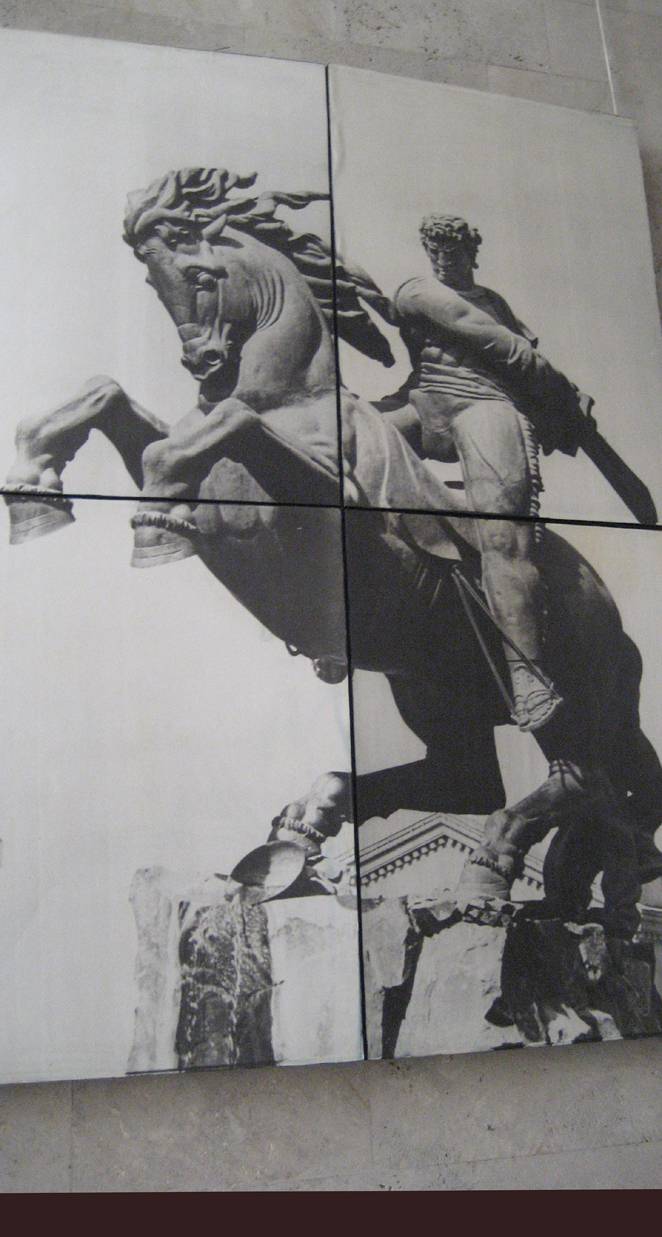
|
| David of Sassoun |
As Anna ended our tour, she concluded by informing us of the ongoing work of the museum, `In addition, of course, to displaying the works of Yervand Kochar, by collecting and preserving, it is also a center for research. Lectures, conferences and meetings are held regularly. The mission of the museum is to promote the history of avant-garde art in Armenia and outside its borders.'
As I departed the museum, having expressed sincere appreciation to Anna and her colleagues, I mused over the extraordinary art that I was privileged to experience and the extraordinary life of Yervand Kochar. His image of Shakespeare in Armenia continued to hover over me. Polonius' famous words to his son Laertes (from Hamlet) kindled in me a sense of the essence of this one single life of a gifted man. How well Shakespeare's celebrated lines illuminate the mission of this loyal son of Armenia, "This above all: to thine own self be true, And it must follow, as the night the day, Thou cans't not be false to any man.'
ENDNOTES:
-- Ruth Bedevian continues her visits in Armenia. Many of her articles are at: http://www.groong.org/orig/armeniahousemuseums.html
|
Redistribution of Groong articles, such as this one, to any other
media, including but not limited to other mailing lists and Usenet
bulletin boards, is strictly prohibited without prior written
consent from Groong's Administrator. © Copyright 2007 Armenian News Network/Groong. All Rights Reserved. |
|---|